|
|
Lateran Obelisk
| Present Site: | Piazza di San Giovanni in Laterano, Rome (North West side of the Basilica di San Giovanni in Laterano) N 41°53'12.6"(41.886836) E 12°30'17.2"(12.504778) |
| Pharaoh: | Thutmose III (The 18th Dynasty, reigned 15th Century BC) - Thutmose IV (reigned beginning of 14th Century BC) |
| Measurement: | 32.18 meters high for obelisk itself |
| Weight: | 455 tons |
| Stone: | Red granite |
About The Site:
This obelisk, Lateran Obelisk (Obelisco Lateranense) is at North West side of the Basilica di San Giovanni in Laterano. The Basilica is one of four major Basilicas in Rome, and the oldest Basilica which was constructed by Constantine the Great in 4th Century. But the current Basilica is the one which was renovated by Pope Sixtus V in 16th Century.
 The Basilica di San Giovanni
The Basilica di San Giovanniand the Lateran Palace |
The next red building of the next right of white Basilicas is the Lateran Palace (Palazzo del Laterano). This was the main papal residence which was used for about 1,000 years until the See is moved to Avignon by "Avignon Papacy" of 1309. The current Palace was reconstructed by Pope Sixtus V in 16th Century, and is slightly smaller than the original Palace.
This Palace is well-known as the place that the "Lateran Treaty", which recognized the Vatican as an independent state, was closed in 1929.
Thus, the Basilica and the Lateran are well-known place, and they are referred in every guidebook on Rome.
It's worth to visit here since the tourists can look around the inside of the Basilica, and the Palace is publicly open as a Museum.
From Termini, most tourists use Metro Line "A" bound for Battistini as many interesting points are this direction. However, San Giovanni Station (for Lateran Obelisk) is on the another direction for Anagnina. On this line also, there are interesting points such as ruin of Ancient Roman Aqueduct, and globally well-known film studio CINECITTA. It would be a good idea that you visit Lateran Obelisk together with those interesting points.
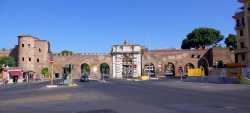 the San Giovanni Gate
the San Giovanni Gate
|
How To Get There:
You may get off at the third stop, San Giovanni Station on Line "A", from Termini.
There is a Aurelian Walls on the north side of the exit. After the San Giovanni Gate on the wall, you can see the white Basilica and the red Palace on the left. The obelisk is behind of that Palace.
By the way, if you take a Bur #81 or #673, you can go to Villa Celimontana, where the Celimontana Obelisk is there. After visiting Lateran Obelisk, visiting of Celimontana Obelisk would be the effective route for visiting the obelisks in Rome.
About The Obelisk:
Largest Obelisk in the World This obelisk is the largest (tallest) obelisk among all the existing Ancient Obelisks in the world, which is said as 32.18 meters in height (*1) with 455 tons in weight (*2). It's 45.7 meters including the pedestal. The lower portion was lost in ancient times, but repair portion is little.
(*1) The Complete Temples of Ancient Egypt, Richard H. Wilkinson.
(*2) The Obelisks of Egypt, Labib Habachi.
This obelisk began to make during the reign of Thutmose III, however the work stopped for 35 years in Amenhotep II reign with unknown reason probably due to the death of Thutmose III. After the death of Amenhotep II, Thutmose III's grandson Thutmose IV finished it. According to the inscription, this obelisk was erected in the Amen Temple, as a single obelisk, although the obelisks usually are made in pairs.
Hieroglyph is engraved with 3 columns on 4 sides, is well preserved. In the center column on 4 sides, the Horus name, coronation name, and birth name of Thutmose III are engraved. On either side of the column carved the name of Thutmose IV, and in the left column of south side shaft, the hieroglyph expressing "35" is seen. The reasons for left derelict 35 years may be writen here.
About 1300 years later, Octavianus (the first Roman Emperor Augustus [reigned 27 BC - AD 14]) liked the Egyptian obelisk when he first conquered Egypt, and then he planned to take the obelisk, which is in Karnak Great Temple, to Rome, but he gave up the plan due to too huge obelisk. In this connection, he took back two another obelisks instead, to Rome. These obelisks were at the Sun Temple in Heliopolis. This is the first transport of the obelisk to Rome. These two obelisks are currently in the Piazza del Popolo (Flaminian Obelisk) and the Piazza di Montecitorio in Rome.
Constantius II transported to Rome Another 300 years later then, it was removed under the orders of the Roman Emperor Constantine I [reigned 306-337]. The pedestal and a large part of its foundation were destroyed during the removal work, and then at least it reached Alexandria safely. He hoped to raise it in his new capital at Constantinople. However he died before the obelisk ever left Egypt, and his son and successor Constantius II [reigned 337-361] had it taken to Rome, instead of Constantinople. Then he fixed it up at the spina [central reservation] of the Circo Massimo [Latin: Circus Maximus], next to an "another" obelisk which is now in the Piazza del Popolo, in 357. Therefore, there
were 2 obelisks here at that time. This scene is illustrated by Joan Blaeu, Dutch cartographer, in 1649, which is posted on Wikimedia.
Circo Massimo is a grand stadium of Ancient Rome, which has 150,000 people of capacity, is often used for chariot racing and other events. The vast site still remains in Rome, and we can imagine how big it was. (See picture)
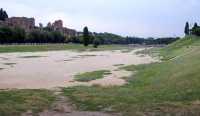 The vast site of Circo Massimo
The vast site of Circo Massimo
|
At some unknown date and by some unknown cause, the obelisk fell. There is no record on this because people seem to have lost the interest in Egyptian culture including obelisk. It was not until the 16th century that the interest in Egypt comes back and Pope Sixtus V ordered a search for it. It was found in around 1587, broken into three pieces, some 7 meters below the surface at the site of former Circo Massimo. On August 3, 1588, after the Christian Cross was added at its apex, then this obelisk was raised in the Piazza di San Giovanni in Laterano, where it has stood ever since.
It's said it was 36 meters long when it was discovered at the site of former Circo Massimo in around 1587. If so, some 4 meters lower portion is missing.
Notes For Pictures:
As I stated above, the Basilica di San Giovanni in Laterano and the Lateran Palace (Palazzo del Laterano) are definitely the historical monuments. Most tourists for Metro Line "A" use the train bound for Battistini, not for Anagnina because most interesting points and the obelisks in Rome (excluding this Lateran Obelisk) are in North West of Rome. Also the obelisk is behind of the buildings (Basilica and Palace). For that reasons, little tourists was here when I visited here in 2013 and 2014.
Just note that the Shuttle Bus between Termini Station (Roma Termini) and Fiumicino Airport (Aeroporto di Fiumicino) passes side of this obelisk. So, you may look it from the window of the bus.
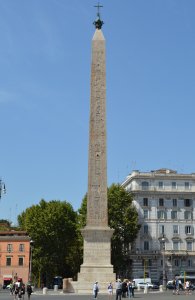 South Side August 11, 2014 |
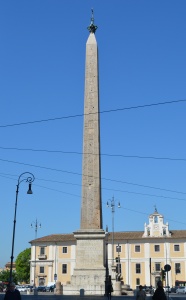 East Side May 5, 2017 |
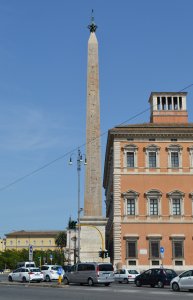 West Side August 11, 2014 |
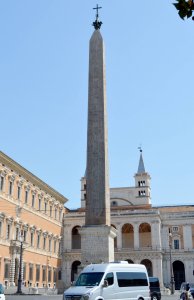 North Side August 11, 2014 |
|||
by Hiroyuki Nagase (For high definition image, please click the picture) | ||||||
Copyright Hiroyuki Nagase nagase@obelisks.org and Shoji Okamoto okamoto@obelisks.org